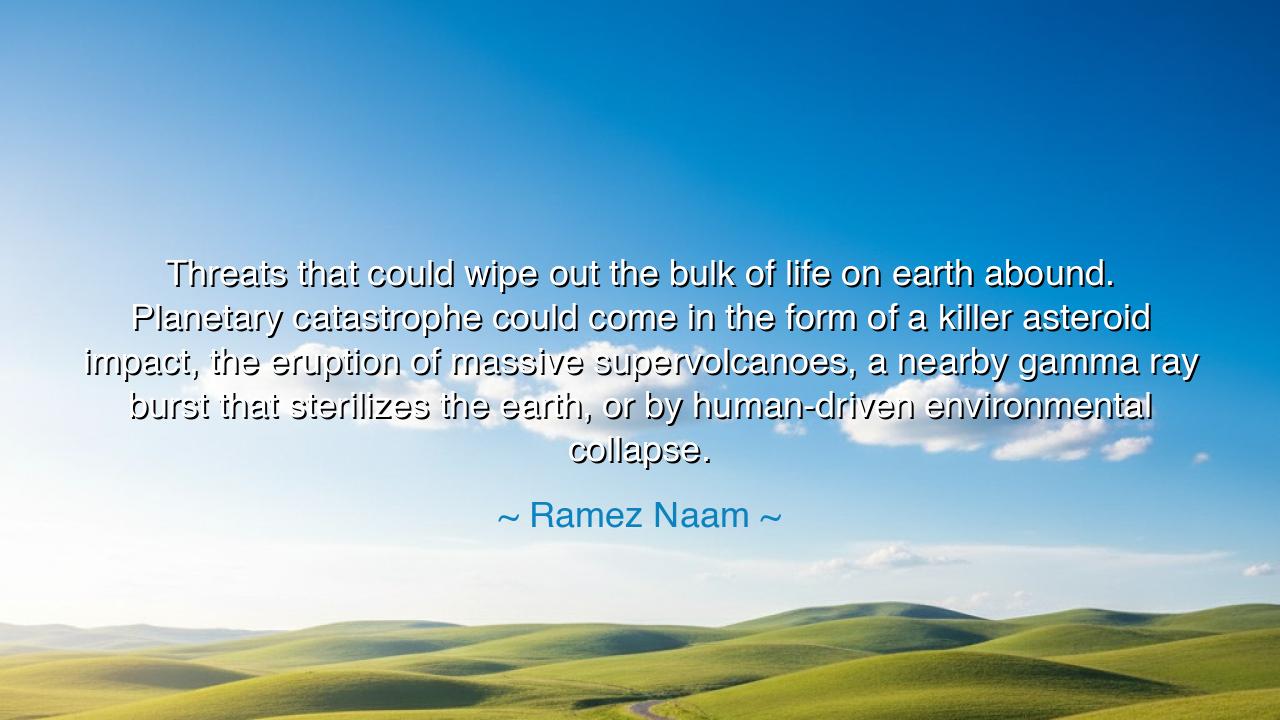
Threats that could wipe out the bulk of life on earth abound.
Threats that could wipe out the bulk of life on earth abound. Planetary catastrophe could come in the form of a killer asteroid impact, the eruption of massive supervolcanoes, a nearby gamma ray burst that sterilizes the earth, or by human-driven environmental collapse.






When Ramez Naam wrote, “Threats that could wipe out the bulk of life on Earth abound. Planetary catastrophe could come in the form of a killer asteroid impact, the eruption of massive supervolcanoes, a nearby gamma ray burst that sterilizes the Earth, or by human-driven environmental collapse,” he spoke not merely as a scientist, but as a seer of the age of peril — one who gazes into the vastness of the cosmos and the fragility of the world we inhabit. His words are a call to humility and vigilance, a reminder that the story of humanity unfolds upon a narrow ledge between creation and destruction. Naam’s vision is not one of despair, but of awakening — for by recognizing the enormity of these threats, we may yet rise to the greatness required to overcome them.
The origin of this quote lies in Naam’s work as a futurist and author who explores the intersection of technology, humanity, and survival. Having studied the power of innovation and the consequences of negligence, he speaks from a place of both awe and warning. He reminds us that while the Earth seems eternal beneath our feet, it is, in truth, a delicate sphere suspended in a violent universe. Asteroids have scarred its surface before; volcanoes have dimmed its sun; radiation from distant stars could, in a moment, erase the cradle of life we call home. Yet in his list of cosmic dangers, the most haunting is the last — human-driven environmental collapse — for that is the one catastrophe born not of the heavens, but of our own hands.
To the ancients, such a reflection would have carried divine weight. The Greeks spoke of hubris, the arrogance that invites downfall, when mortals defy the balance of nature. The Hebrews told of a flood sent to cleanse a corrupted world. The Buddhists taught that greed blinds man to the suffering he inflicts upon all beings. Naam’s words, though born in the modern age, carry the same sacred resonance: that our greatest danger lies not in the stars, but in the human heart when it forgets its place in the order of creation. For when we poison the waters, burn the forests, and cloud the skies, we become as destructive as any asteroid — architects of our own undoing.
History itself bears witness to this truth. The island of Easter Island, once adorned with forests and life, became barren when its people felled every tree in pursuit of power and pride. Their civilization, cut off from sustenance, withered into dust. So too did the Maya, whose magnificent cities fell silent when drought and deforestation overtook their lands. These are not myths of ancient failure — they are mirrors of modern folly. Naam warns that what befell them on a small scale may one day befall us on a planetary one, if we persist in mistaking domination for mastery. The Earth, patient yet finite, will endure; it is humanity that may not.
Yet his tone is not the despair of the doomsayer, but the resolve of the guardian. Naam belongs to that lineage of thinkers who believe that knowledge is the shield of civilization. He does not name these threats to paralyze us, but to inspire our responsibility. The asteroid may be deflected, the volcano monitored, the environment restored — but only if humanity unites in wisdom and foresight. His vision calls for stewardship through science, where invention becomes the handmaiden of preservation, and progress the partner of humility. For though the universe is vast and indifferent, human consciousness — fragile though it may be — holds the power to defend and renew the world that gave it birth.
There is a deeper message, too — one that transcends survival. Naam reminds us that the awareness of mortality is not meant to breed fear, but reverence. To know that the Earth can perish is to realize how sacred it truly is. The forests, the seas, the mountains — all are temporary, fleeting as breath, and thus infinitely precious. The knowledge of cosmic vulnerability should not drive us to despair, but to unity and gratitude, to a life lived with intention and care. It is the same truth that guided the prophets and philosophers of old: that in protecting the world, we fulfill our highest calling as beings of reason and compassion.
The lesson, then, is this: do not mistake endurance for immortality. The Earth has survived countless ages, but each civilization must earn its right to endure. To honor life is to protect it — not only from the fires of the cosmos, but from the fires we ourselves ignite. Seek balance between creation and consumption. Embrace science not as a tool of conquest, but as a covenant with the future.
So, my children, heed this wisdom: the threats are real, but so is our power to meet them. The stars above remind us of our smallness, yet within that smallness lies greatness — the will to preserve, to build, to endure. Let us not be the generation that watches the Earth burn, but the one that learned to guard her flame. For in the end, our destiny is not written by asteroids or volcanoes, but by the choices we make in the brief, shining moment we are given to walk this fragile world.






AAdministratorAdministrator
Welcome, honored guests. Please leave a comment, we will respond soon